I have multiple points forming many circles on a 2d plane and need to identify and sort them for further calculation. I have the [x, y] co-ordinates of each point and a number representing each point.
All point numbers in one circle should be sorted in a list. and then point numbers of next circle should follow. Say each circle is formed by 6 points. They should be first and then next 6 points of the adjacent circle should follow.
I identified that Convex Hull is a way of identifying closed polygons. This is similar but I want it to identify multiple convex hulls in the same plane. I think this should be possible in python. Can anyone help on this please?
Edit:
- the circles don't overlap
- the circles are all the same size, i.e. same radius
- every circle has the same number of points.
- they are evenly spaced holes. the hole radius is very specific - 10mm and the entire array is rectangular shaped. a Plate with an array of evenly spaced holes - albeit - row of holes are staggered.
Schematic: Circles on a plate. Each circle is defined by 10 points. We have the (x,y) co-ordinates of these points
